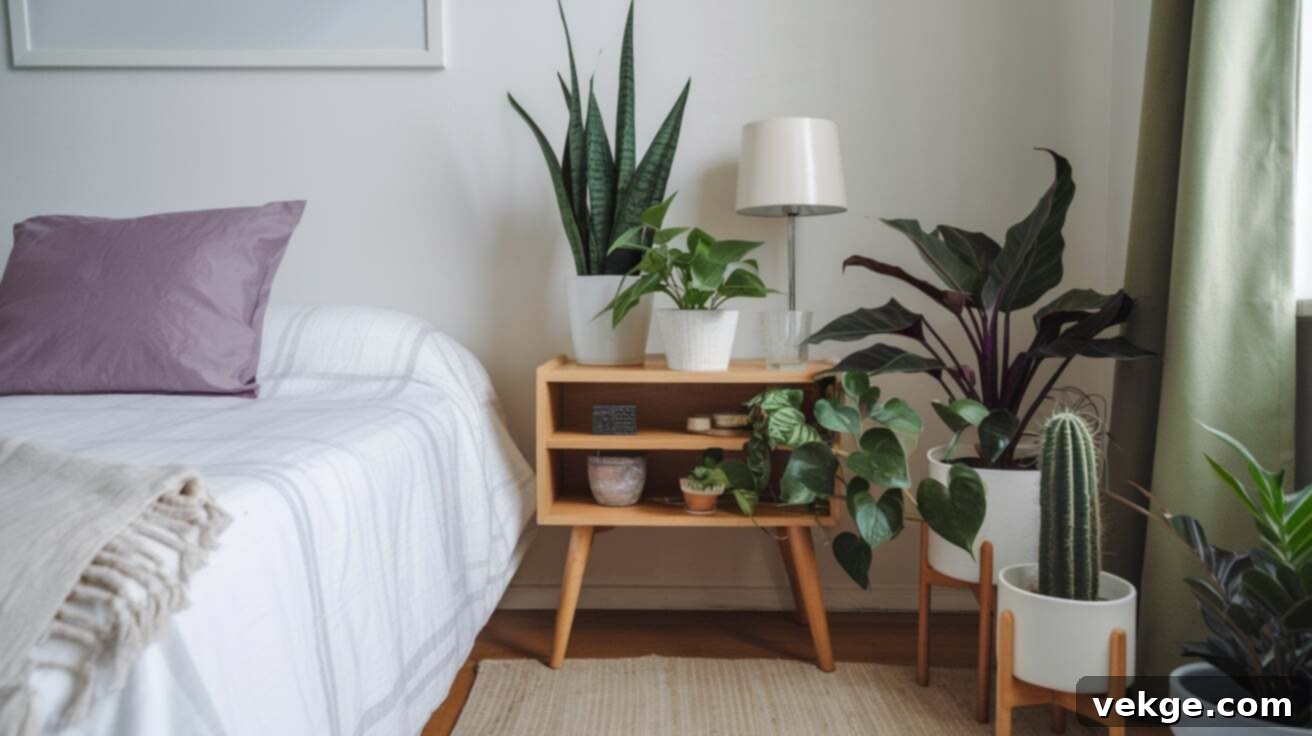Transform Your Bedroom: 25 Best Plants for Better Sleep, Air Quality & Serene Decor
Your bedroom should be a sanctuary—a peaceful retreat where you can unwind, recharge, and enjoy restorative sleep. While many focus on paint colors, lighting, and bedding, a powerful yet often overlooked element can significantly enhance this vital space: plants. More than just decorative accents, strategically placed greenery can elevate your bedroom’s aesthetic, improve air quality, and even contribute to better sleep and overall well-being.
This comprehensive guide will explore 25 inspiring plant ideas specifically chosen to thrive in bedroom environments. We’ll delve into their unique characteristics, care requirements, and how they can transform your personal space into a tranquil oasis. From resilient air-purifying varieties to fragrant blooms that promote relaxation, you’ll discover plants that perfectly suit your lifestyle, decor preferences, and commitment to creating a healthier, happier bedroom.
Get ready to infuse your sleeping quarters with life, color, and natural harmony. These plant-inspired design tips will help you cultivate an environment that supports deep relaxation, cleaner air, and a profound sense of calm.
Why Bedroom Plants Are More Than Just Decor
Integrating plants into your bedroom goes far beyond mere aesthetics. There’s a growing body of evidence supporting the positive impact of indoor plants on human health and well-being. This phenomenon, often referred to as biophilic design, suggests that humans have an innate tendency to connect with nature, and bringing natural elements indoors can significantly enhance our living spaces.
- Improved Air Quality: Plants naturally filter the air by absorbing common indoor pollutants like formaldehyde, benzene, and trichloroethylene, which can off-gas from furniture, carpets, and cleaning products. They also release oxygen, especially during the day, contributing to a fresher breathing environment.
- Reduced Stress and Anxiety: Studies indicate that interacting with plants can lower cortisol levels, reduce blood pressure, and evoke feelings of calmness. The presence of greenery can create a more relaxing atmosphere, helping to alleviate daily stressors before sleep.
- Enhanced Sleep Quality: Certain plants possess properties that directly aid in sleep. Some release soothing scents, while others actively release oxygen at night, which can be beneficial in a closed bedroom environment.
- Increased Humidity: Plants release moisture into the air through transpiration. This natural humidifying effect can be particularly helpful in dry climates or during winter months when indoor heating dries out the air, potentially easing respiratory issues and dry skin.
- Boosted Mood and Productivity: Even in a resting space, a touch of nature can lift spirits. Waking up to vibrant greenery can start your day on a positive note, contributing to overall happiness and a sense of well-being.
Understanding these benefits underscores the value of thoughtfully chosen plants in creating not just a beautiful, but a truly healthful and restorative bedroom environment.
25 Best Plants to Transform Your Bedroom into a Serene Retreat
1. Snake Plant (Sansevieria trifasciata)
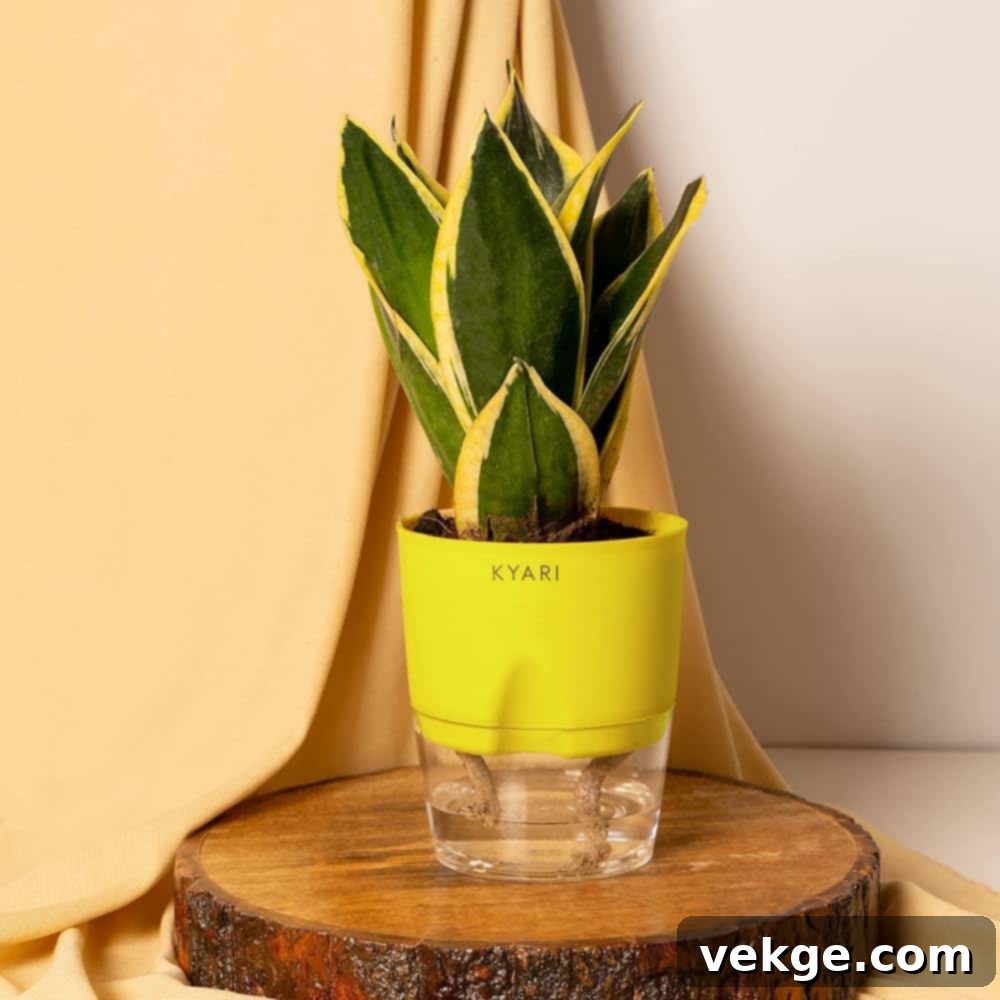
Also known as Mother-in-Law’s Tongue, this striking plant features tall, rigid, sword-like leaves with unique patterns and often variegated edges. Its architectural form makes it a popular choice for modern interior designs. Beyond its aesthetic appeal, the Snake Plant is celebrated for its remarkable ability to purify air, particularly by converting carbon dioxide into oxygen at night, making it an ideal bedroom companion.
- Care Level: Easy
- Light: Adaptable to low light but thrives in bright, indirect light
- Watering: Allow soil to thoroughly dry out between waterings to prevent root rot
- Benefits: Exceptional air purifier, releases oxygen at night, highly tolerant of neglect
2. Peace Lily (Spathiphyllum)
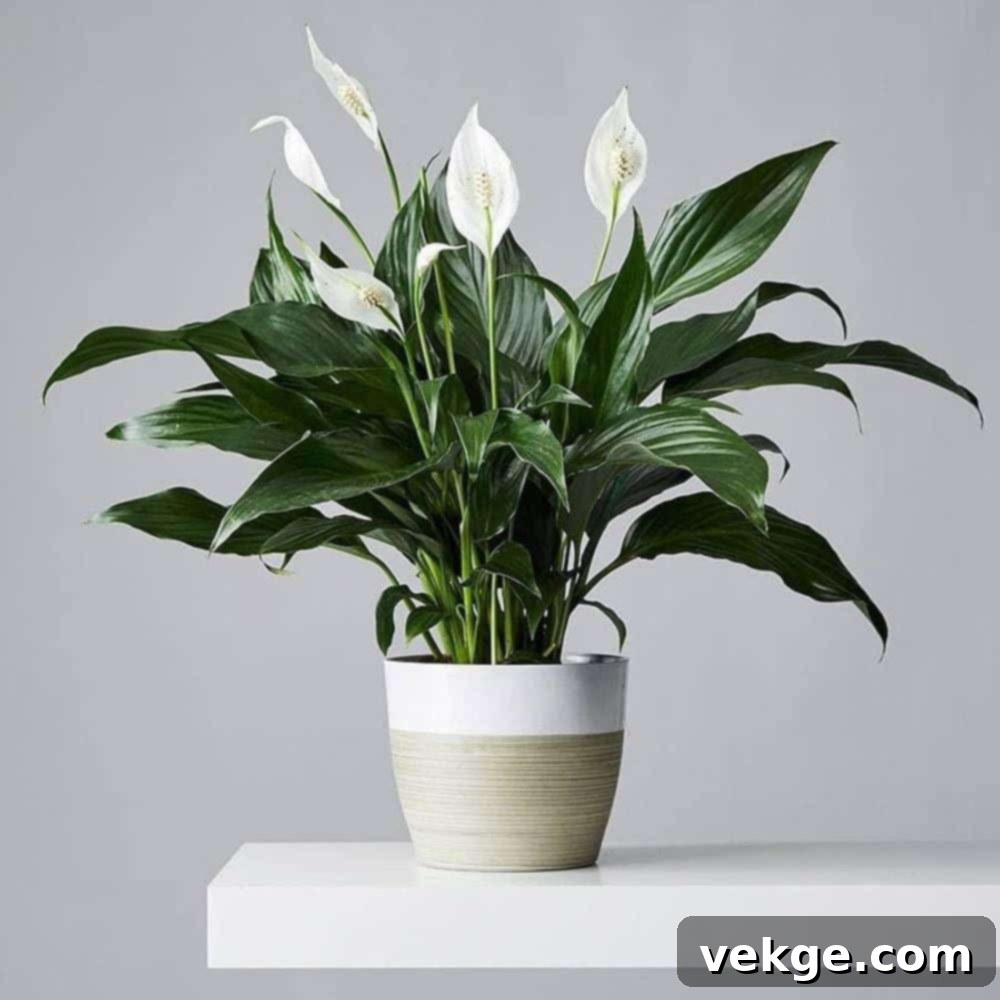
The Peace Lily is renowned for its elegant glossy green leaves and distinctive white, hood-like spathes (modified leaves that resemble flowers). This beautiful plant is not only a symbol of tranquility but also a powerhouse in removing common indoor air pollutants such as benzene, formaldehyde, and trichloroethylene. Its ability to humidify the air slightly also contributes to a more comfortable sleeping environment.
- Care Level: Moderate
- Light: Low to medium indirect light; direct sun can scorch leaves
- Watering: Keep soil consistently moist but not waterlogged; it will droop dramatically when thirsty
- Benefits: Highly effective at removing toxins, boosts room humidity, adds a touch of sophistication
3. Aloe Vera
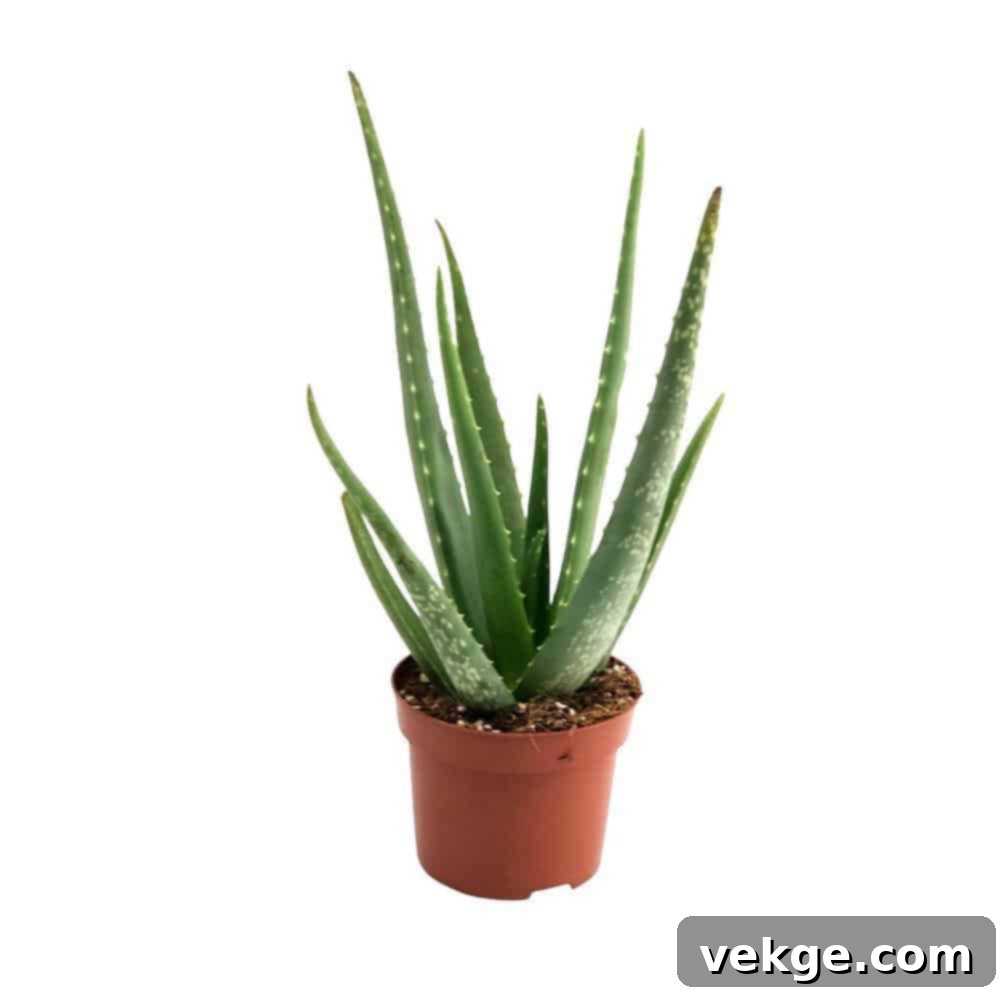
This distinctive succulent is easily recognizable by its thick, pointed, fleshy leaves arranged in a rosette pattern. More than just a striking decorative plant, Aloe Vera is incredibly practical. The gel inside its leaves is a well-known natural remedy for minor burns, skin irritations, and cuts. Like the Snake Plant, it also contributes to better air quality by releasing oxygen at night.
- Care Level: Easy
- Light: Prefers bright, indirect sunlight; can tolerate some direct sun
- Watering: Water sparingly; allow the soil to dry completely between waterings, as it is highly drought tolerant
- Benefits: Air purifier, natural soothing remedy for skin, low maintenance
4. Lavender (Lavandula)
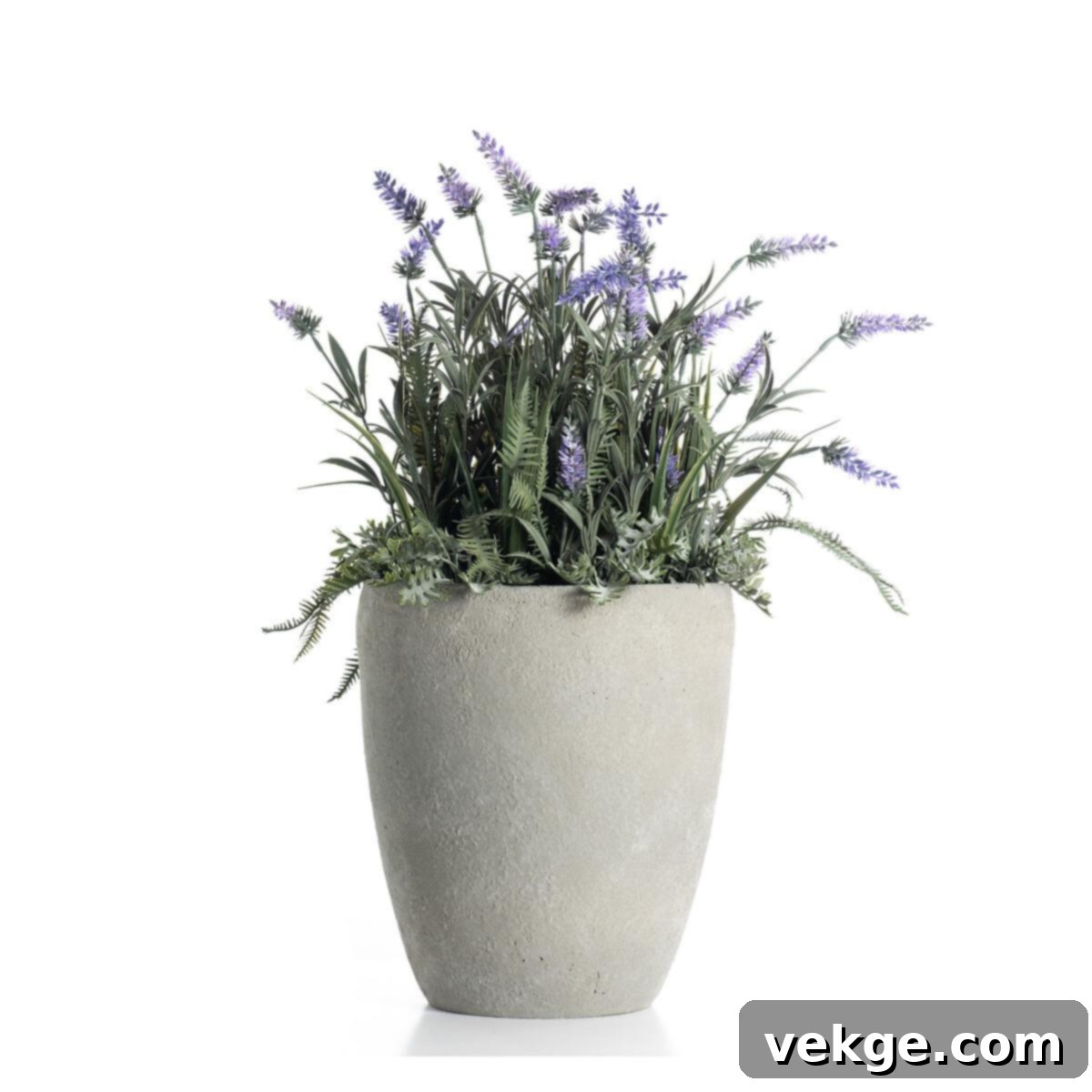
Renowned for its beautiful purple blooms, silvery-green foliage, and unmistakable aroma, Lavender is a classic choice for promoting relaxation. The scent released by its essential oils, particularly linalool, has been scientifically linked to reduced heart rate, decreased anxiety, and improved sleep quality. Placing a potted lavender plant in your bedroom can create a naturally soothing and aromatic atmosphere.
- Care Level: Moderate (requires specific conditions indoors)
- Light: Needs abundant full sunlight to thrive (at least 6 hours daily)
- Watering: Water when the top inch of soil is dry; ensure good drainage and avoid overwatering
- Benefits: Potent aromatherapy for relaxation, reduces anxiety, significantly improves sleep quality
5. Pothos (Epipremnum aureum)
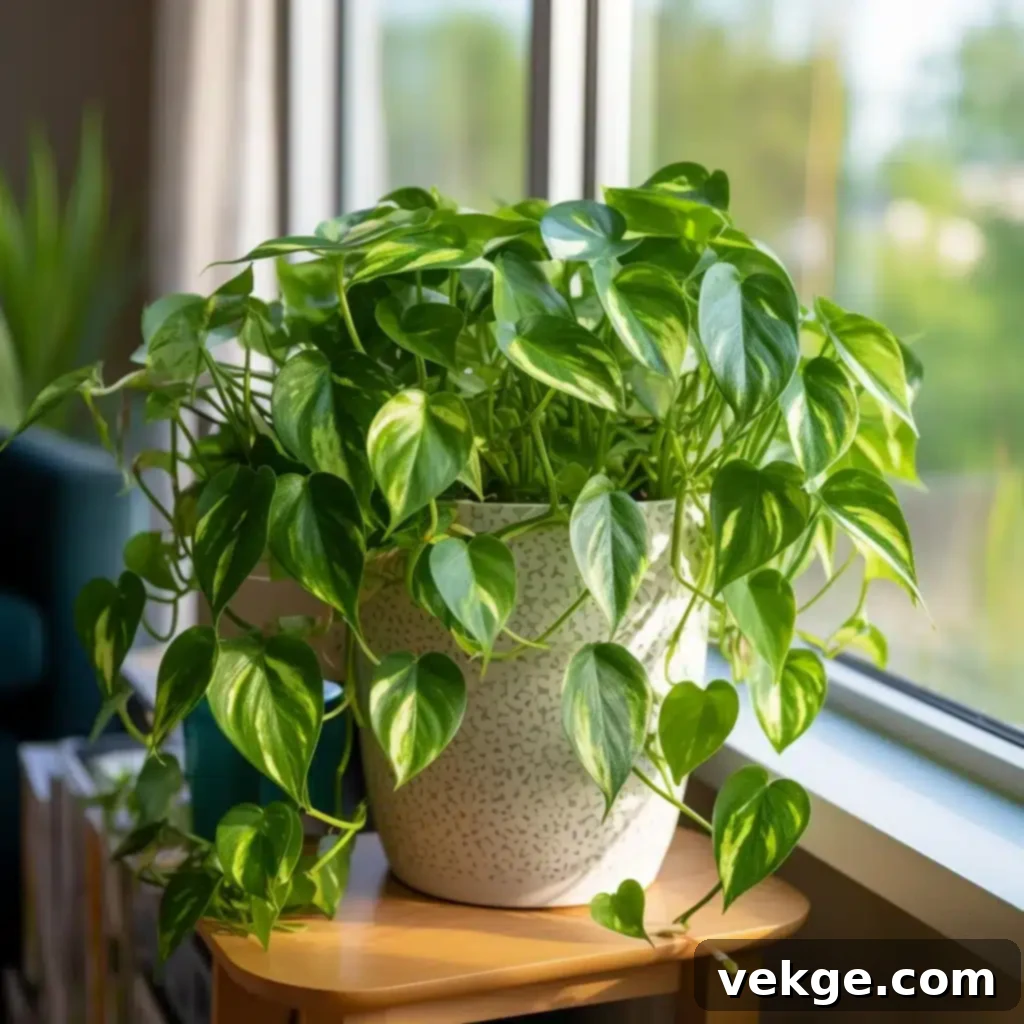
With its beautiful cascading vines and vibrant heart-shaped leaves, Pothos is an incredibly versatile and forgiving plant. It adds an instant touch of lush greenery, making it ideal for shelves, hanging planters, or even trailing from the top of a dresser. Often called “devil’s ivy” because of its hardiness, Pothos is also effective at filtering airborne toxins like formaldehyde, benzene, and xylene.
- Care Level: Easy
- Light: Tolerates low to bright indirect light, though variegation may fade in very low light
- Watering: Let the soil dry out completely between waterings; it’s quite drought-tolerant
- Benefits: Excellent air purifier, extremely easy to grow and maintain, versatile in placement
6. ZZ Plant (Zamioculcas zamiifolia)
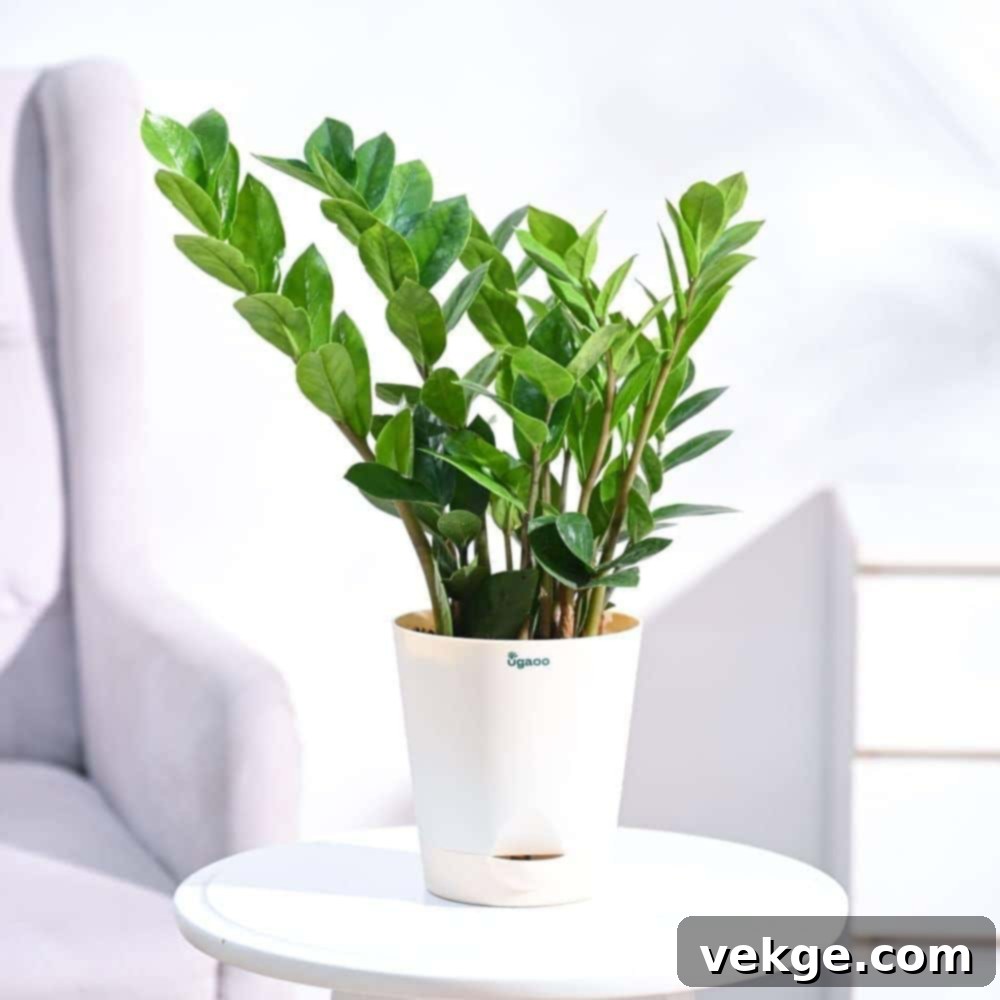
The ZZ plant is a remarkably resilient and low-maintenance houseplant, perfect for beginners or those with busy lifestyles. It features shiny, dark green, oval-shaped leaves arranged symmetrically on upright stems, giving it a sleek, modern appearance. Its unique look makes it a stylish addition to any bedroom, providing a splash of deep green without demanding much attention. It’s also an effective air purifier.
- Care Level: Easy (one of the easiest!)
- Light: Thrives in low to medium indirect light; avoid direct sunlight
- Watering: Water sparingly, only when the soil is completely dry; it stores water in its rhizomes
- Benefits: Extremely low maintenance, excellent air purifier, highly drought tolerant
7. Spider Plant (Chlorophytum comosum)
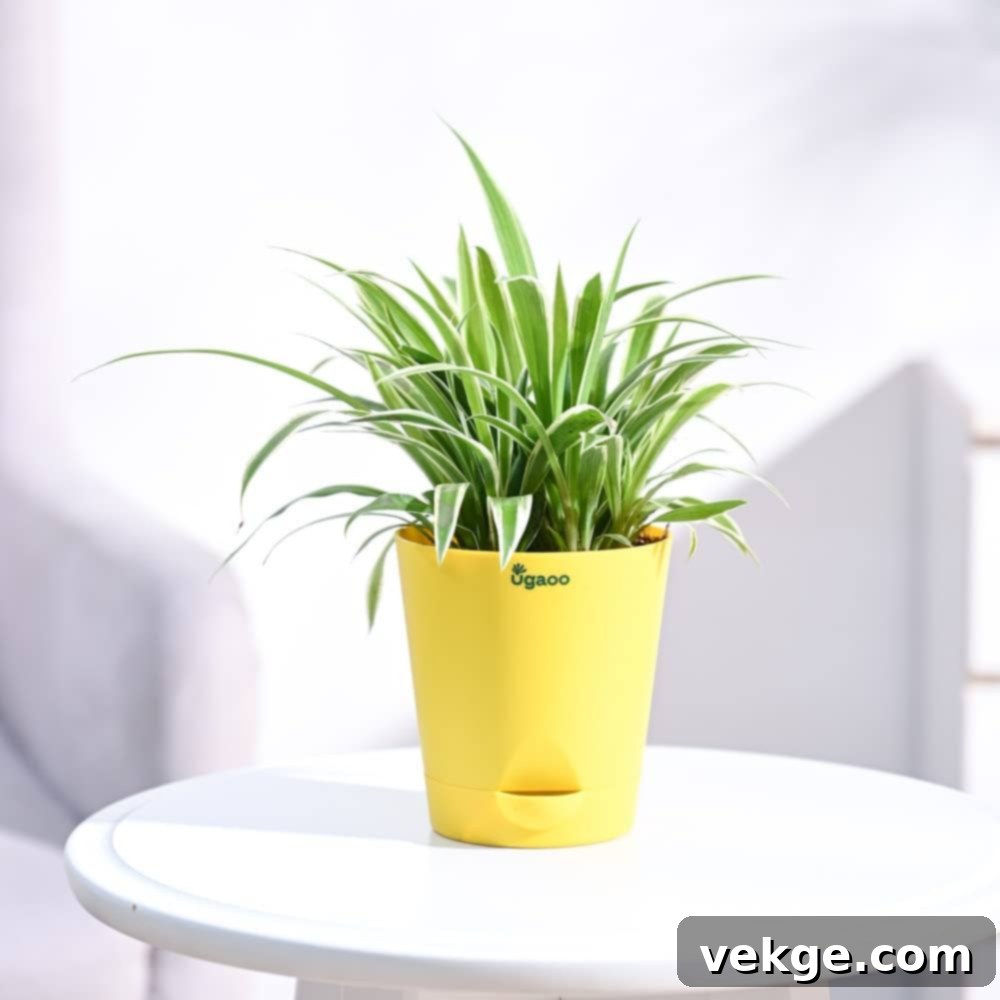
Named for its small offshoot plantlets that dangle from the mother plant like spiders on a web, the Spider Plant features long, arching leaves with distinctive white or cream stripes. It’s a classic choice for both beginner and experienced plant owners due to its hardiness and ease of care. Spider Plants are also highly effective at removing common indoor air pollutants such as formaldehyde and xylene, contributing to a cleaner bedroom atmosphere.
- Care Level: Easy
- Light: Prefers bright, indirect light; can tolerate lower light but growth may slow
- Watering: Water when the top inch of soil is dry; susceptible to root rot if overwatered
- Benefits: Excellent air purifier, easy to propagate, adds a cheerful, vibrant look
8. Boston Fern (Nephrolepis exaltata ‘Bostoniensis’)

With its lush, lacy, and arching fronds, the Boston Fern brings a delicate touch of woodland charm and natural elegance to any bedroom. It’s an excellent choice for creating a soft, tranquil atmosphere and thrives in higher humidity, making it a natural humidifier. Besides its beauty, this fern is highly efficient at removing airborne toxins, including formaldehyde and xylene, improving your bedroom’s air quality.
- Care Level: Moderate (requires consistent moisture and humidity)
- Light: Indirect sunlight; direct light can burn the fronds
- Watering: Keep soil consistently moist, but not soggy; thrives in high humidity (mist regularly or use a pebble tray)
- Benefits: Powerful air purifier, natural humidifier, adds a serene, green aesthetic
9. English Ivy (Hedera helix)
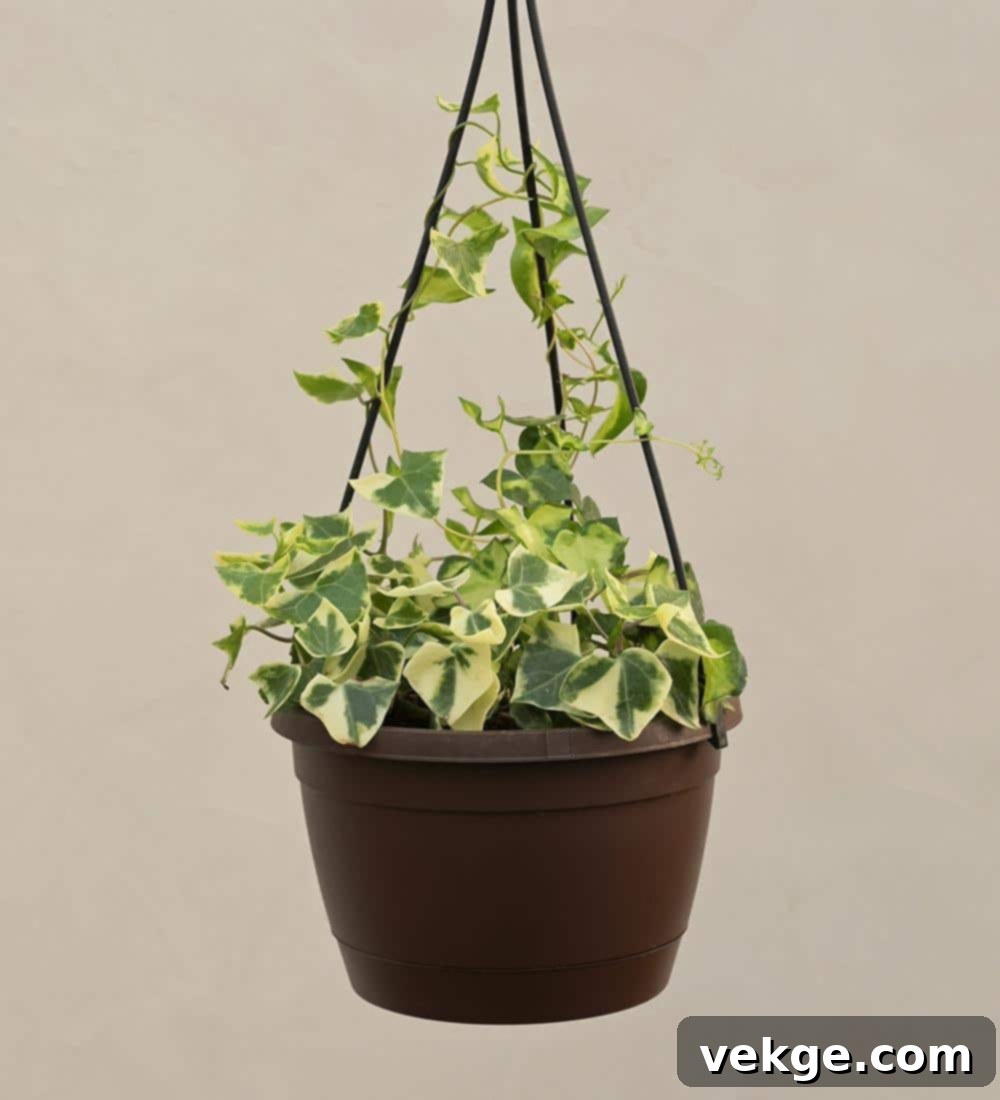
English Ivy, with its classic lobed leaves and trailing habit, brings a touch of timeless elegance and natural grace to your bedroom. This versatile plant can be trained to climb on trellises, cascade from hanging baskets, or simply trail along shelves. Beyond its decorative appeal, English Ivy is highly valued for its air-purifying capabilities, particularly its effectiveness in reducing airborne fecal particles and mold, which can significantly improve indoor air quality.
- Care Level: Moderate
- Light: Prefers indirect sunlight; some varieties tolerate low light
- Watering: Keep soil consistently moist but allow the top layer to dry slightly between waterings
- Benefits: Improves air quality by reducing mold and airborne particles, versatile for various display methods
10. Rubber Plant (Ficus elastica)
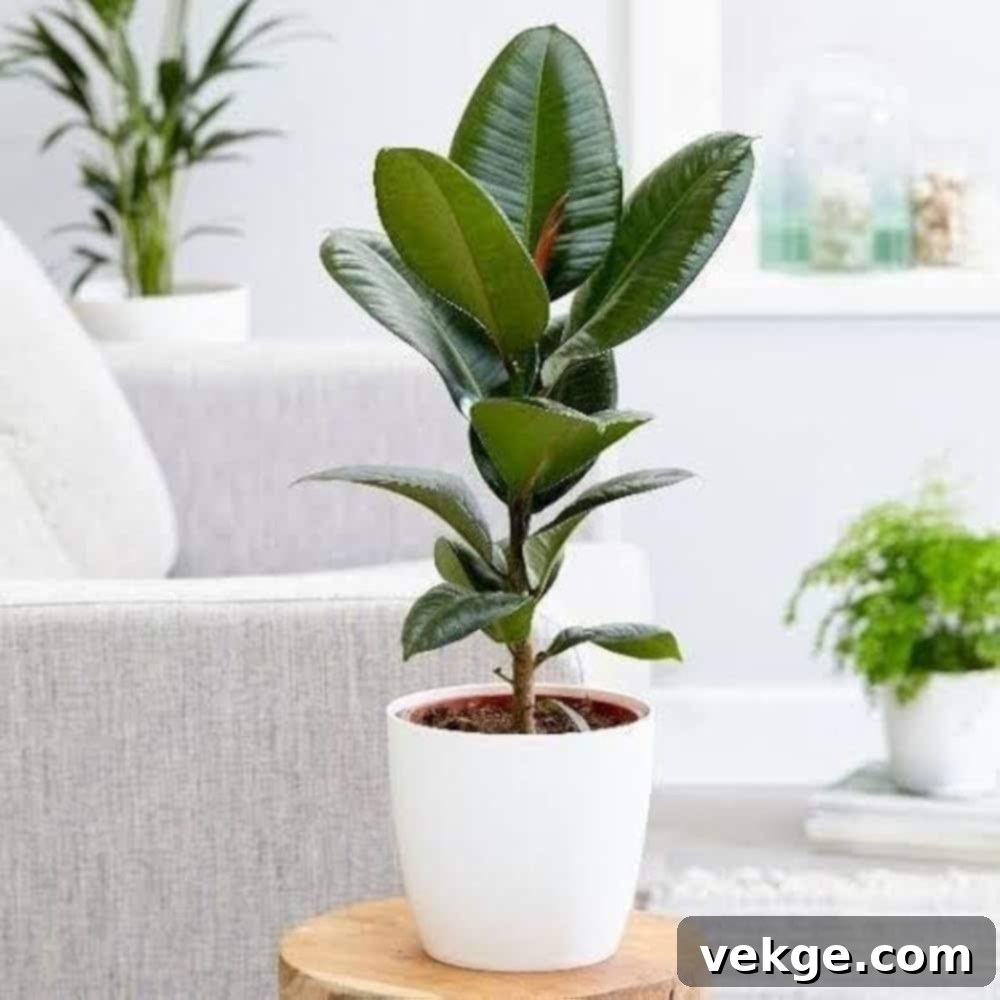
Known for its large, thick, glossy, and deep green leaves, the Rubber Plant makes a striking focal point in any bedroom. Its bold foliage and upright growth habit lend a sophisticated, modern look, easily becoming a statement piece. Beyond its commanding presence, the Rubber Plant is an effective air purifier, adept at removing toxins like formaldehyde from the indoor environment, contributing to a healthier sleeping space.
- Care Level: Moderate
- Light: Prefers bright, indirect light; direct sunlight can scorch leaves
- Watering: Water when the top inch or two of soil dries out; reduce watering in winter
- Benefits: Powerful air purifier, adds a bold and modern aesthetic, relatively low maintenance once established
11. Philodendron (Heartleaf Philodendron – Philodendron hederaceum)
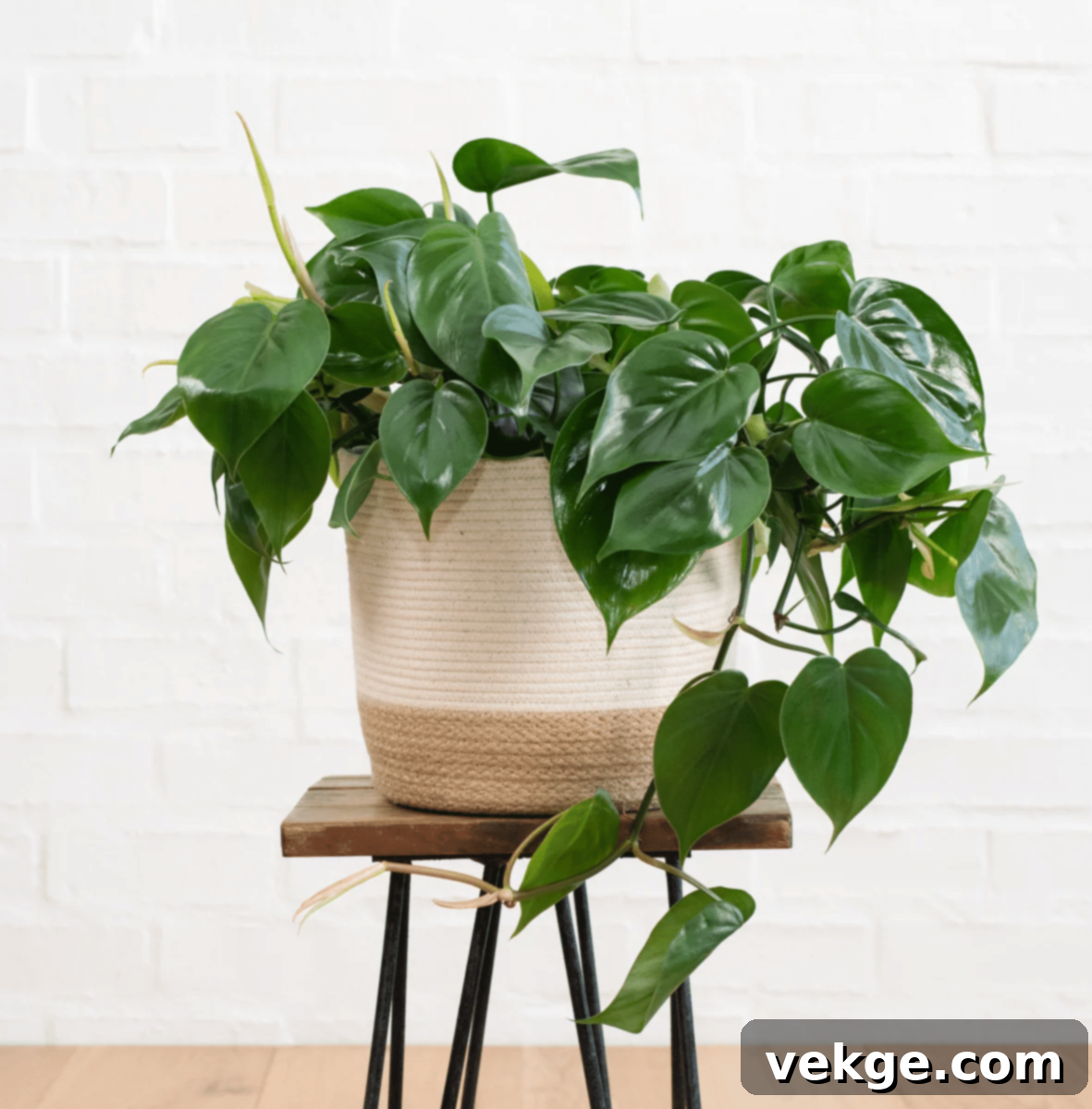
The heart-shaped leaves of the Philodendron are a classic choice for houseplants, bringing a gentle, tropical touch to your bedroom. Available in various forms, including popular climbing and non-climbing varieties, it’s highly adaptable and resilient. Its graceful trailing vines are perfect for adding greenery to shelves or hanging baskets. Philodendrons are also excellent at purifying indoor air, removing formaldehyde and other volatile organic compounds.
- Care Level: Easy
- Light: Tolerates low to bright indirect light; avoid direct sun
- Watering: Allow the top inch of soil to dry between waterings; more forgiving of underwatering than overwatering
- Benefits: Excellent air purifier, highly adaptable to various conditions, adds a lush, tropical feel
12. Jade Plant (Crassula ovata)
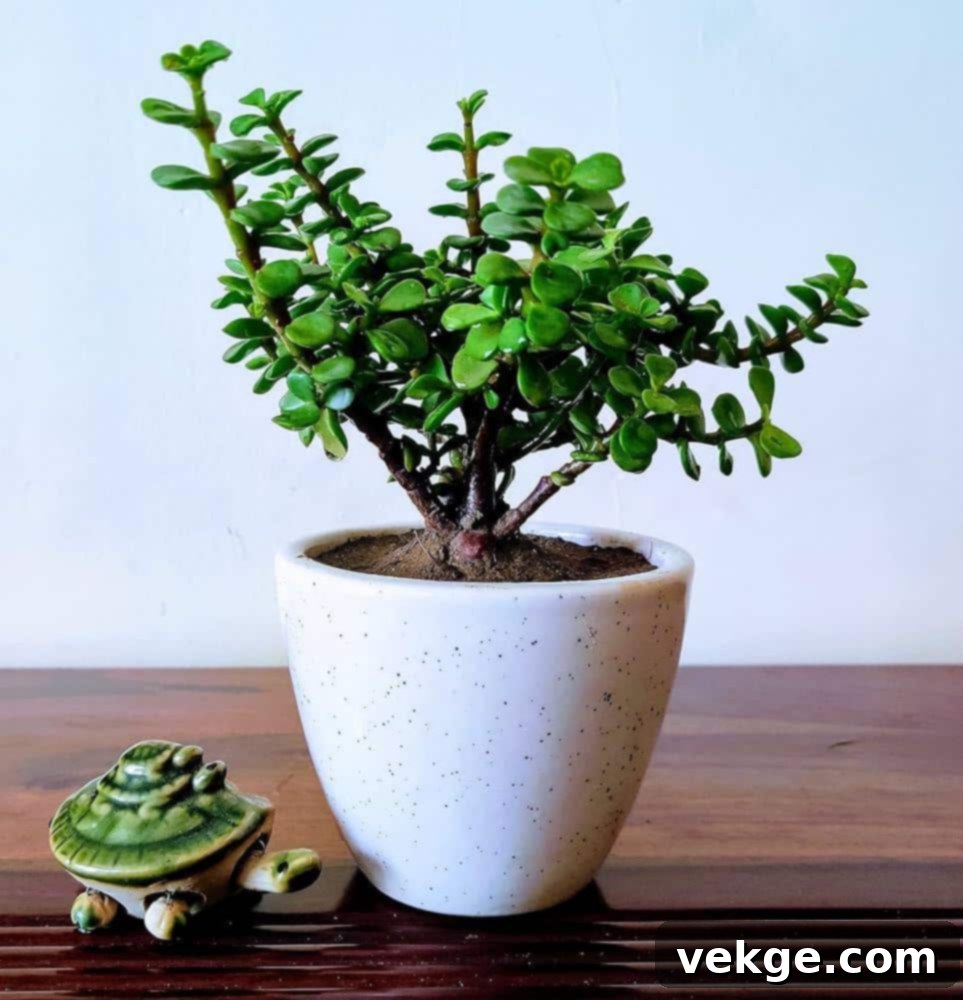
The Jade Plant is a popular succulent characterized by its thick, woody stems and smooth, glossy, oval-shaped leaves. Often associated with good fortune and prosperity in various cultures, it adds a touch of tranquil elegance and a zen-like vibe to any bedroom. Its sculptural form makes it an attractive accent plant, and its minimal watering needs make it incredibly easy to care for, especially for busy individuals.
- Care Level: Easy
- Light: Prefers bright indirect to direct light; adequate light promotes compact growth
- Watering: Water thoroughly only when the soil is completely dry; highly drought tolerant
- Benefits: Extremely low maintenance, long-lived, adds a stylish, zen aesthetic to your space
13. Monstera Deliciosa (Swiss Cheese Plant)
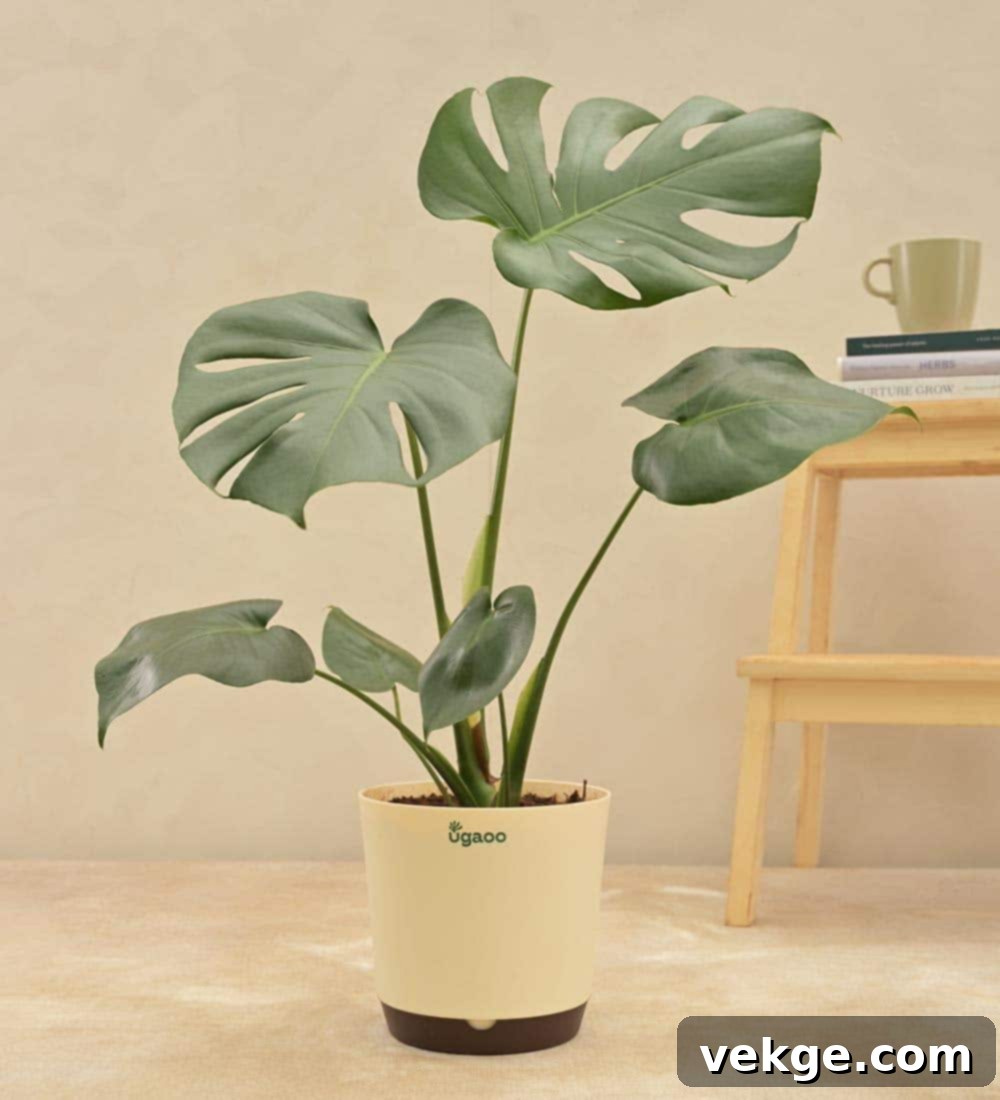
Often called the Swiss Cheese Plant due to the distinctive natural holes and splits in its large, glossy leaves, Monstera Deliciosa is a statement-making plant. It brings an undeniable bold, tropical flair and a touch of architectural drama to any bedroom space. As it matures, its fenestrated leaves become even more impressive. Monsteras are also known for their ability to purify air and release oxygen, creating a healthier environment.
- Care Level: Moderate
- Light: Thrives in bright, indirect light; direct sun can scorch its leaves
- Watering: Water when the top inch or two of soil is dry; allow good drainage
- Benefits: Excellent air purifier, highly stylish and decorative, adds a striking tropical focal point
14. Fiddle Leaf Fig (Ficus lyrata)
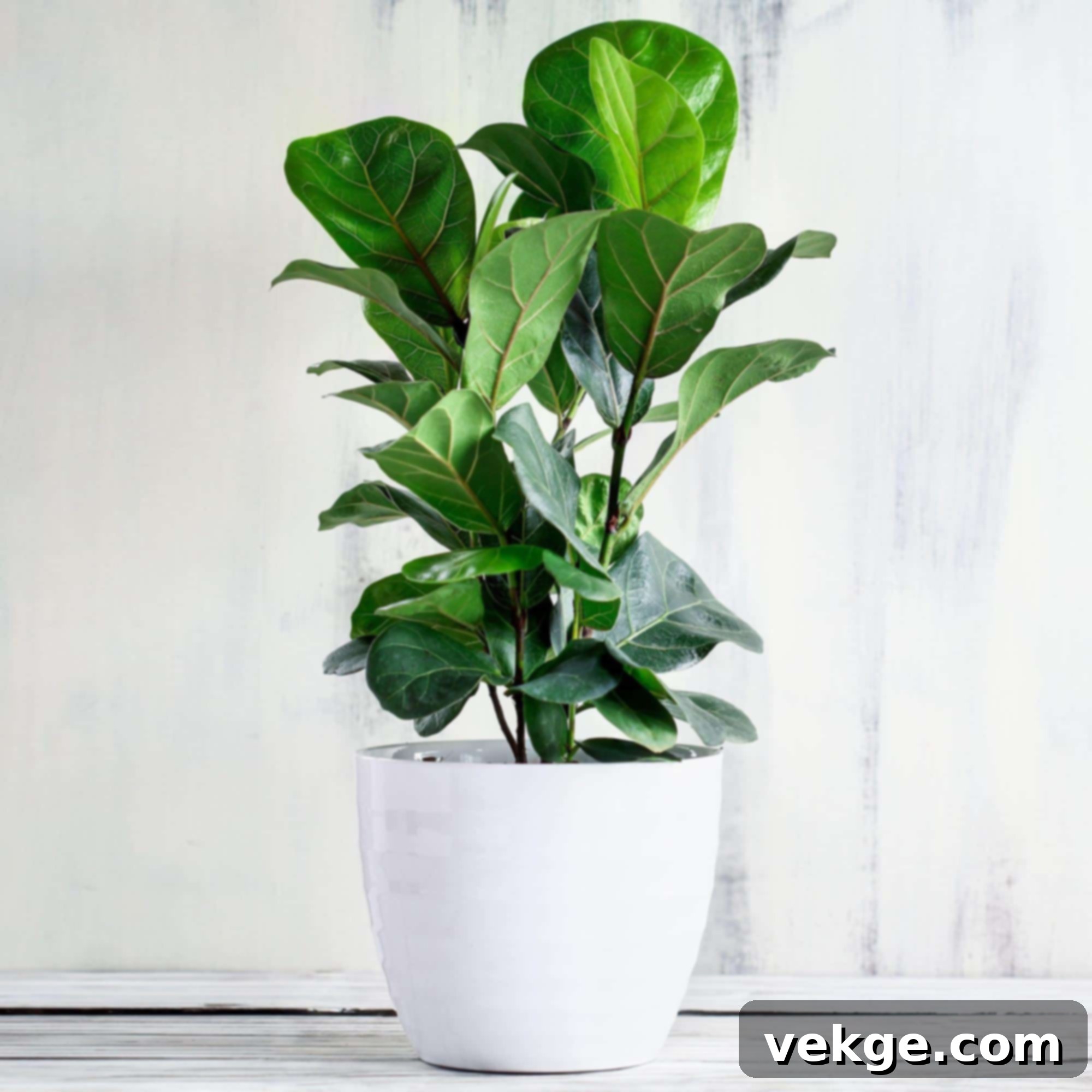
The Fiddle Leaf Fig is a highly sought-after houseplant known for its large, violin-shaped, glossy green leaves. It can grow into an impressive small tree indoors, making a dramatic and elegant statement in a spacious bedroom. While it requires specific care, its striking appearance and air-purifying capabilities make it a worthwhile addition. Other Ficus varieties like the Weeping Fig are also popular choices for their sculptural qualities.
- Care Level: Moderate (can be particular about its environment)
- Light: Requires bright, indirect light; ideally near a large window
- Watering: Water when the top inch of soil is dry; ensure proper drainage to prevent root rot
- Benefits: Impressive statement plant, improves indoor air quality, adds a touch of high-end design
15. Chinese Evergreen (Aglaonema)
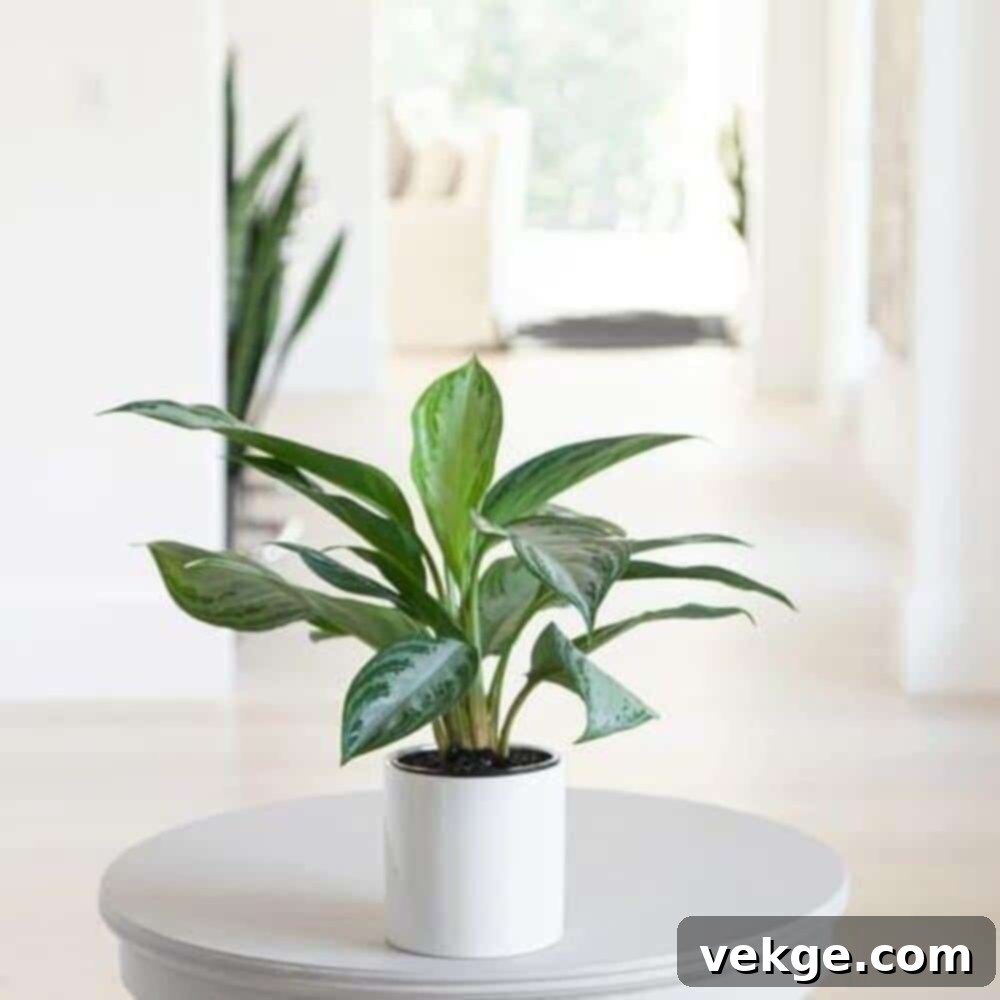
The Chinese Evergreen is prized for its attractive, variegated leaves, which come in a stunning array of shades—from deep greens to silvers, and even vibrant pinks and reds. Its striking patterns make it an excellent choice for adding consistent visual interest and color to your bedroom decor, even in dimmer corners. This plant is also celebrated for its robust air-purifying qualities and its tolerance for lower light conditions, making it quite versatile.
- Care Level: Easy
- Light: Thrives in low to medium indirect light; direct sun can burn its leaves
- Watering: Water when the topsoil is dry; tolerates some neglect but prefers consistent moisture
- Benefits: Highly tolerant of low light, excellent air purifier, offers diverse and colorful foliage
16. Orchids (Phalaenopsis Orchid)
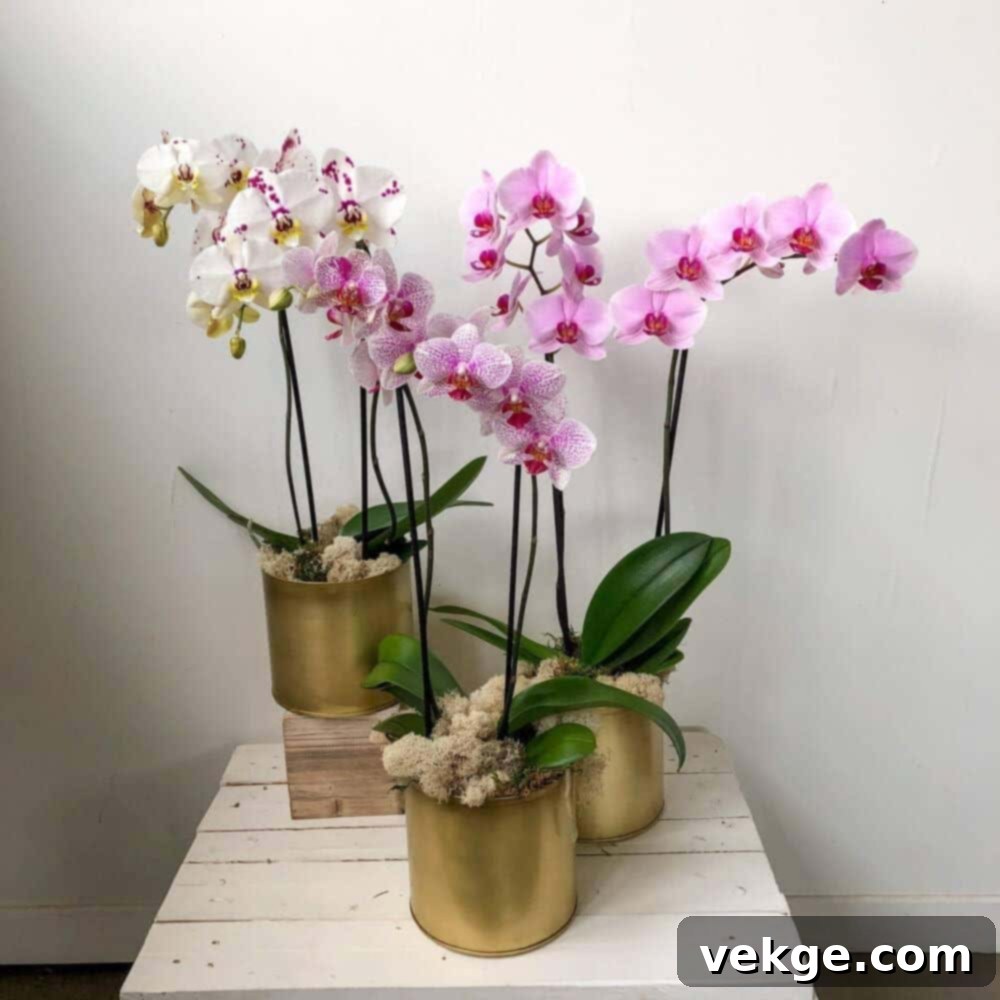
Orchids, particularly the popular Phalaenopsis (Moth Orchid), are admired for their exquisite, long-lasting blossoms that come in a breathtaking spectrum of colors and patterns. Placing an orchid in your bedroom can instantly elevate the space, bringing a touch of refined elegance and exotic beauty. While they require specific care, the reward is a continuous display of stunning, vibrant flowers that can brighten your day and soothe your senses.
- Care Level: Moderate (requires specific watering and light)
- Light: Bright, indirect light; an east-facing window is often ideal
- Watering: Water when the potting mix is dry (often every 7-10 days); do not let sit in standing water
- Benefits: Long-lasting, beautiful blooms, adds color and sophistication, can rebloom with proper care
17. Calathea (Prayer Plant)
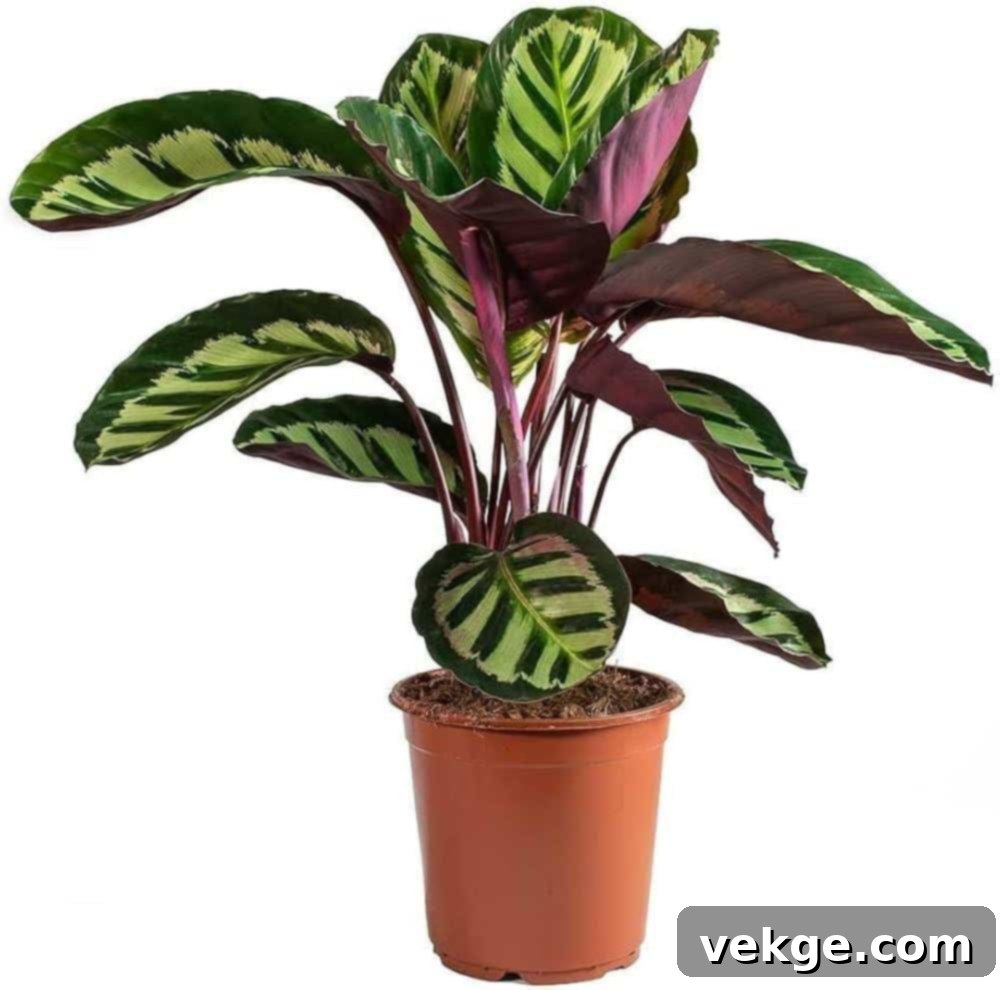
Calatheas are true works of art, known for their extraordinarily striking leaf patterns and vibrant colors, often featuring intricate designs on their upper surfaces and rich purple undersides. Nicknamed “prayer plants,” their leaves famously fold up at night and unfurl again in the morning, adding a dynamic, living element to your bedroom. They are also effective air purifiers, contributing to a healthier and more visually captivating sleep environment.
- Care Level: Moderate (requires higher humidity)
- Light: Prefers low to medium indirect light; direct sun can fade patterns
- Watering: Keep soil consistently moist; prefers distilled or filtered water to avoid leaf tip burn
- Benefits: Features eye-catching, unique foliage, excellent air purifier, adds movement and life to the room
18. String of Pearls (Senecio rowleyanus)

This unique succulent is truly a conversation starter, featuring small, bead-like leaves that elegantly trail down from its pot, resembling a string of pearls. Its delicate, whimsical appearance makes it an ideal choice for hanging baskets or perching on high shelves in your bedroom, where its graceful vines can be fully appreciated. As a succulent, it’s also wonderfully drought-tolerant, making it a relatively low-maintenance option for adding texture and visual interest.
- Care Level: Moderate (prone to overwatering)
- Light: Prefers bright, indirect light; can tolerate some direct morning sun
- Watering: Water only when the soil is completely dry; sensitive to overwatering which causes rot
- Benefits: Highly decorative and unique, drought tolerant, perfect for hanging displays
19. Bamboo Palm (Chamaedorea seifrizii)
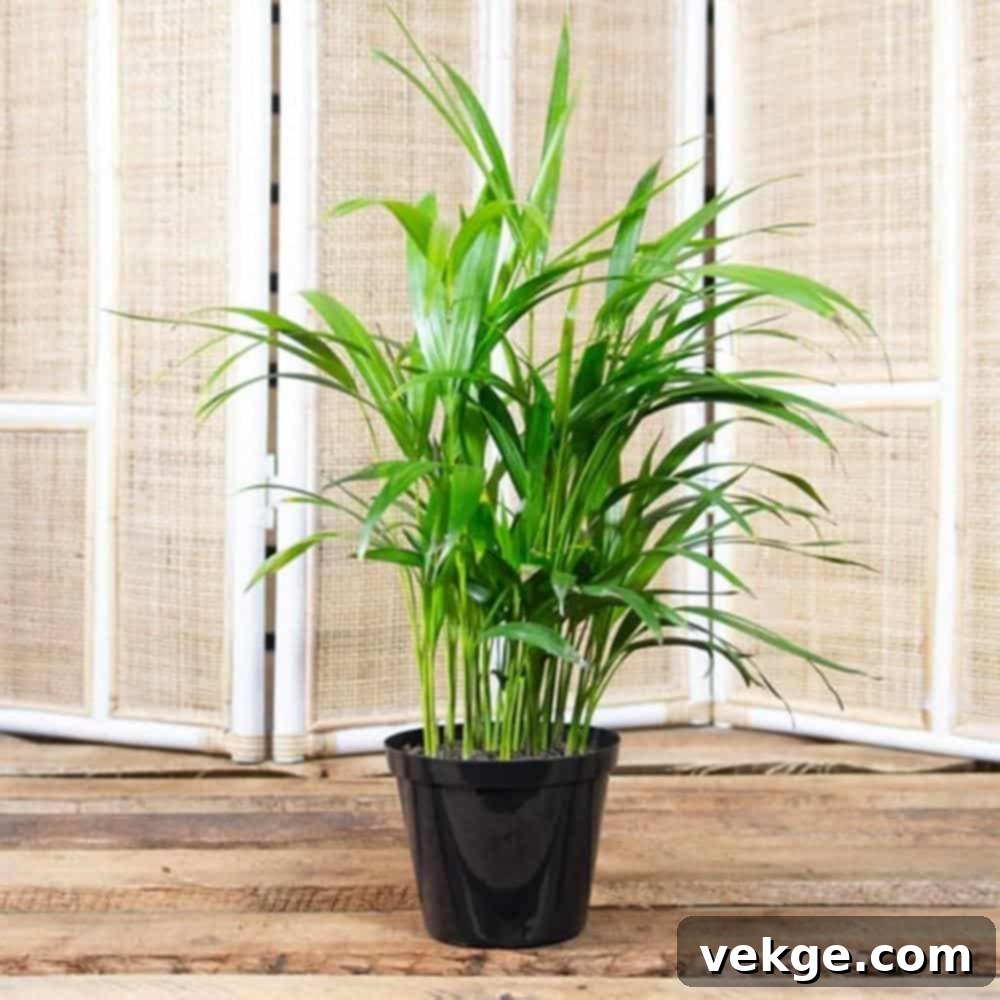
The Bamboo Palm features delicate, feathery fronds and slender, cane-like stems reminiscent of bamboo, lending an instant tropical and airy vibe to your bedroom. It’s an excellent choice for larger spaces where it can grow to an impressive size, making a significant visual impact. This palm is also a top performer in air purification, particularly effective at removing formaldehyde and benzene, while also naturally increasing indoor humidity.
- Care Level: Easy
- Light: Tolerates low to bright indirect light; avoid direct sun
- Watering: Keep soil consistently moist but never soggy; prefers high humidity
- Benefits: Excellent air purifier, natural humidifier, adds a lush, tropical aesthetic to larger rooms
20. Areca Palm (Dypsis lutescens)
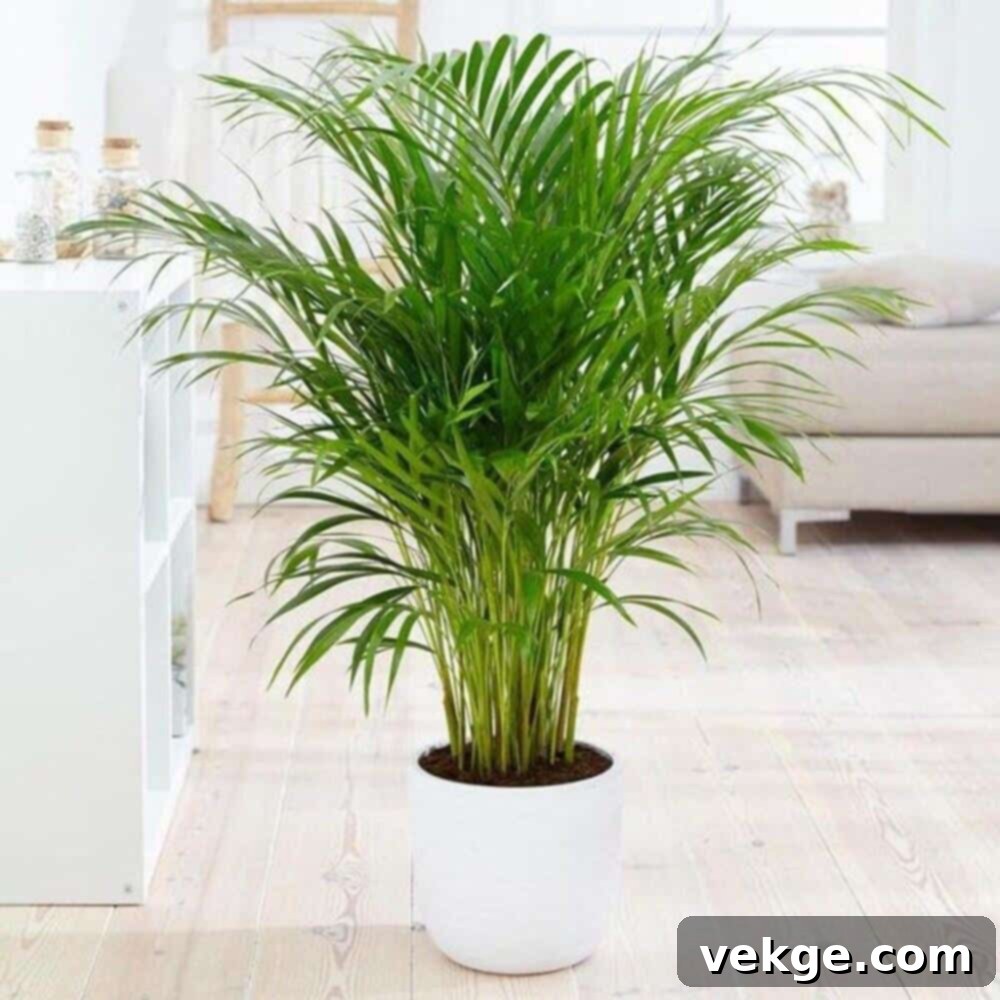
With its striking, arching, feathery fronds that grow upright, the Areca Palm can effortlessly create a vibrant, tropical, and elegant atmosphere in your bedroom. Its tall stature and dense foliage make it an excellent choice for filling empty corners or even serving as a natural, living room divider. Beyond its aesthetic appeal, the Areca Palm is celebrated for its impressive ability to purify the air and release significant amounts of moisture, acting as an effective natural humidifier.
- Care Level: Moderate
- Light: Prefers bright, indirect light; too much direct sun can scorch fronds
- Watering: Keep soil evenly moist, but not waterlogged; sensitive to fluoridated water
- Benefits: Powerful air purifier and humidifier, adds a stylish and tall green presence
21. Eucalyptus (Eucalyptus globulus – as cut foliage)
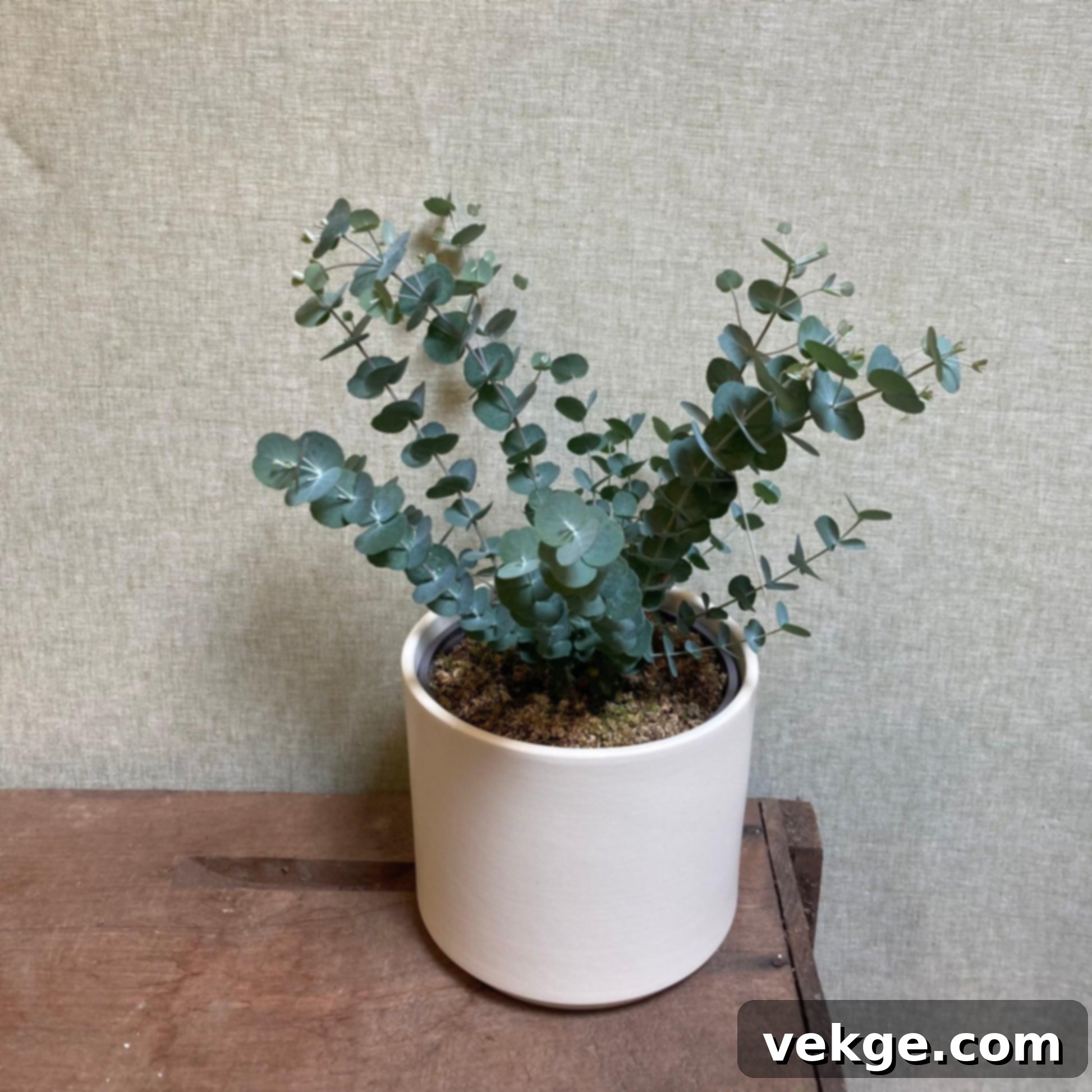
While often used as cut foliage rather than a potted plant indoors, fresh eucalyptus branches can bring a refreshing and invigorating scent to your bedroom. Its silvery-blue, rounded leaves are visually appealing, and its strong, clean aroma, rich in eucalyptol, is known for its calming and stress-reducing properties. Hanging a bundle in your shower or placing it in a vase near your bed can aid in relaxation and help clear congestion, promoting a sense of well-being.
- Care Level: Moderate (as a potted plant) / Easy (as cut branches)
- Light: As a plant, requires bright, indirect light; cut branches need no light
- Watering: As a plant, keep soil consistently moist; cut branches just need water in a vase
- Benefits: Distinctive aromatic properties aid in relaxation and stress reduction, aesthetically pleasing foliage
22. Maidenhair Fern (Adiantum)
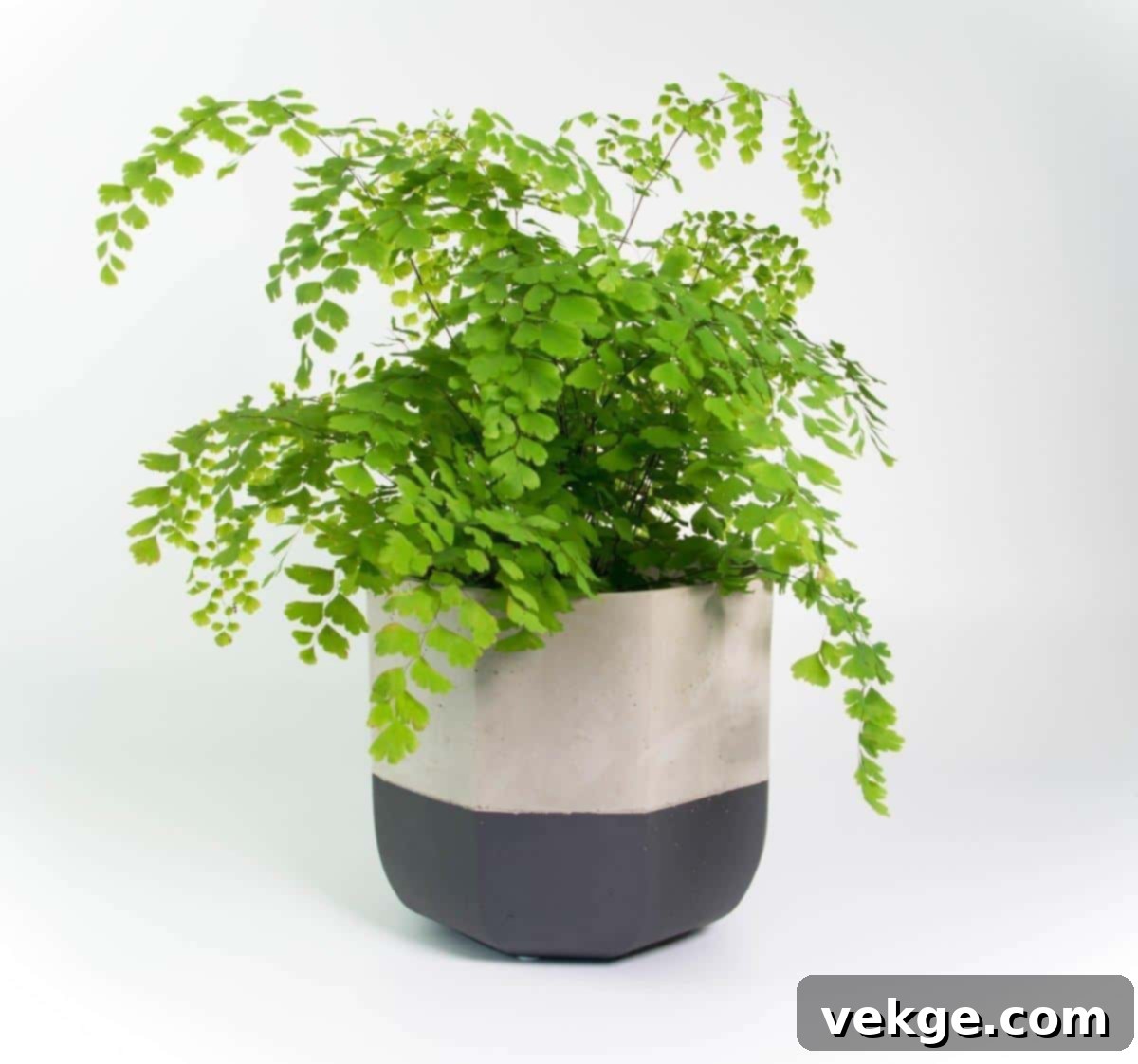
Maidenhair Ferns are renowned for their delicate, airy fronds and fine, black stems, creating a soft, ethereal, and romantic feel. These graceful plants thrive in consistently humid environments, making them perfect for bedrooms where you might also use a humidifier, or in a terrarium setting. While they require attentive care, their unparalleled elegance and ability to subtly humidify the air make them a cherished addition for those seeking a sophisticated natural touch.
- Care Level: Moderate to Difficult (requires high humidity and consistent moisture)
- Light: Prefers indirect light; direct sun will burn delicate fronds
- Watering: Keep soil consistently moist; never let it dry out completely. High humidity is crucial.
- Benefits: Air purifier, significantly adds to humidity, offers unparalleled delicate beauty
23. Anthurium (Anthurium andraeanum)
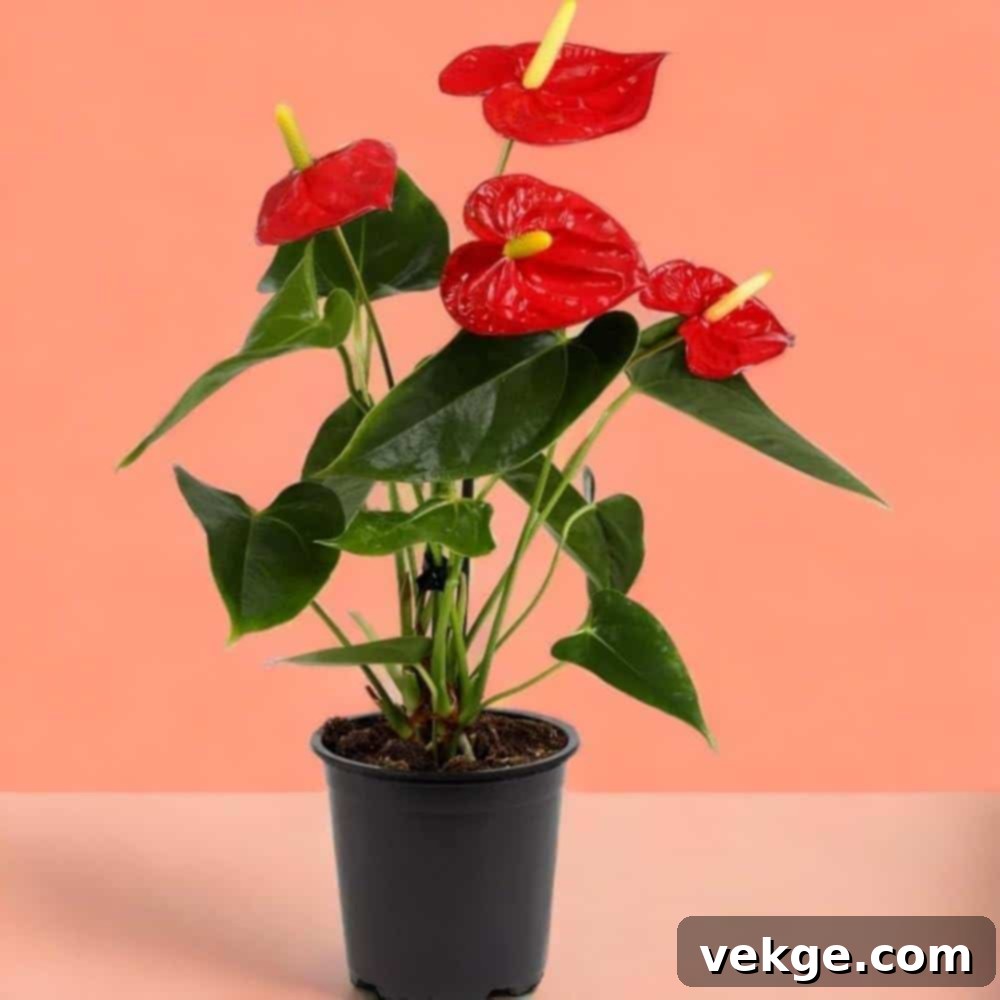
Recognized for its glossy, heart-shaped leaves and vibrant, waxy, heart-shaped “flowers” (which are actually modified leaves called spathes), the Anthurium is a spectacular plant that brings a continuous burst of color to your bedroom. Its blooms can last for weeks or even months, providing a striking visual appeal in shades of red, pink, white, or orange. Beyond its ornamental value, Anthurium is also effective at purifying air, specifically targeting ammonia, formaldehyde, and xylene.
- Care Level: Moderate
- Light: Prefers bright, indirect light; too little light can reduce flowering
- Watering: Keep the soil lightly moist; allow the top inch to dry before rewatering
- Benefits: Long-lasting, vibrant blooms, excellent air purifying qualities, adds a tropical pop of color
24. Bird’s Nest Fern (Asplenium nidus)
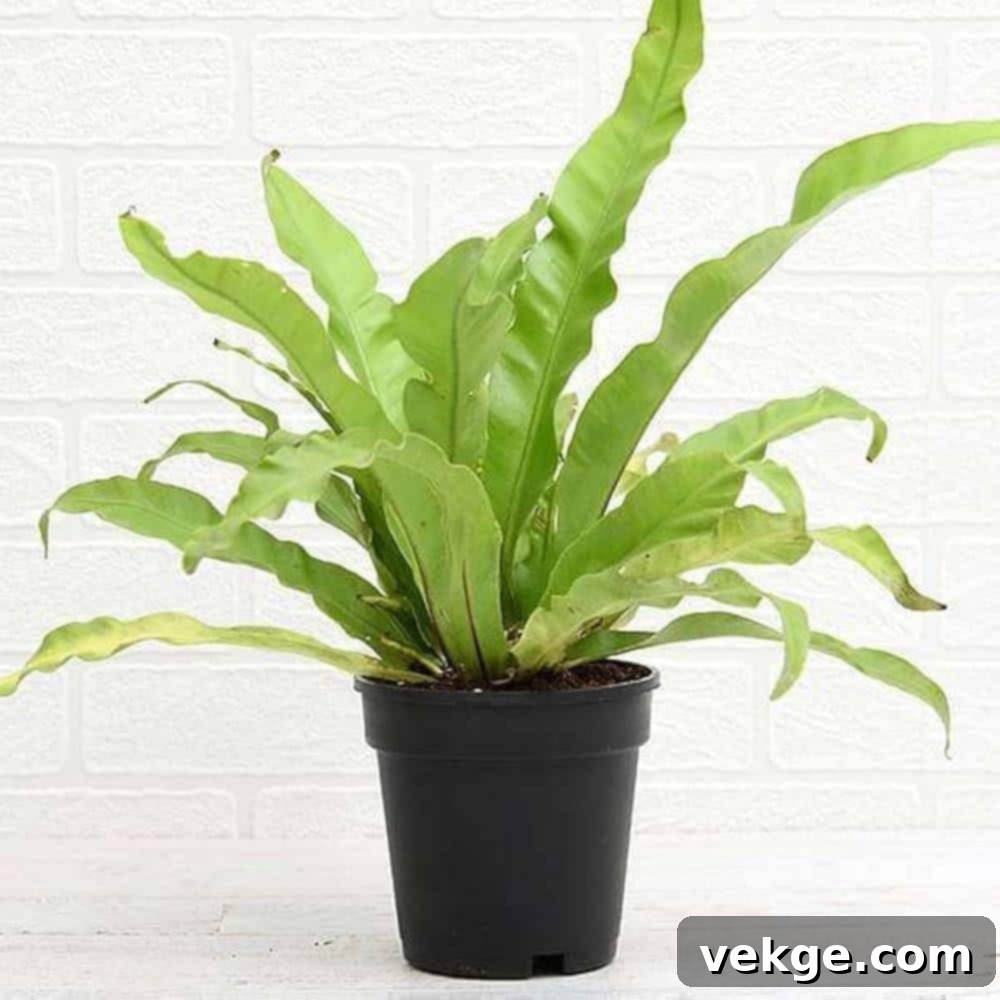
The Bird’s Nest Fern stands out with its wide, rippled, and sometimes wavy fronds that grow in a circular, rosette pattern, truly resembling a bird’s nest. This unique growth habit and texture add an interesting and distinctive botanical element to your bedroom greenery, breaking up monotonous patterns. Like other ferns, it appreciates humidity and contributes to a fresher indoor environment by purifying the air and releasing moisture.
- Care Level: Moderate
- Light: Thrives in low to bright indirect light; avoid direct sun, which can scorch its fronds
- Watering: Keep soil consistently moist, watering around the base of the plant (not directly into the “nest”)
- Benefits: Unique and sculptural appearance, adds humidity, helps purify the air
25. Jasmine (Jasminum polyanthum)
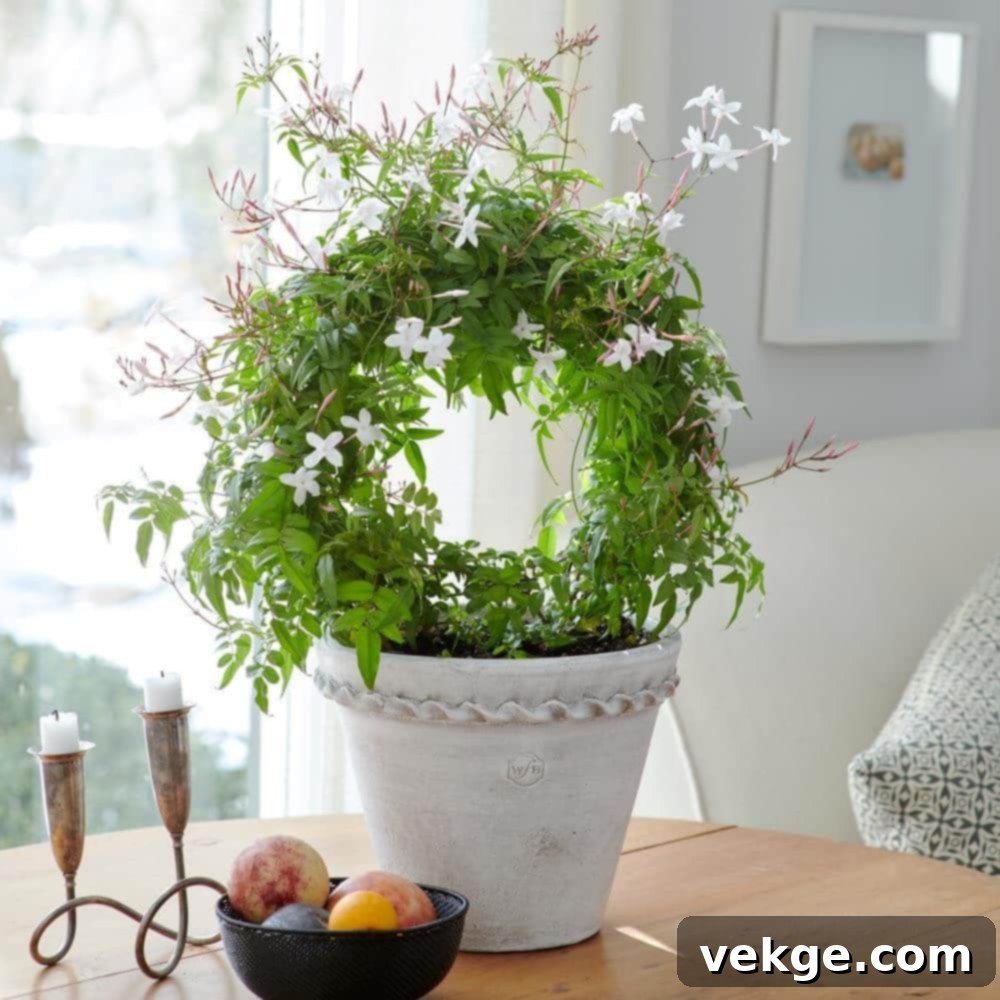
Known for its intoxicatingly sweet fragrance and delicate white or pale pink flowers, Jasmine is a truly romantic and sensory addition to any bedroom. The potent aroma released by its blossoms is widely used in aromatherapy for its profound calming effects, helping to reduce anxiety, alleviate stress, and significantly improve sleep quality. Placing a potted jasmine plant near your bed can fill your space with a natural, soothing perfume, creating a truly luxurious and peaceful atmosphere.
- Care Level: Moderate (requires specific light and care indoors)
- Light: Prefers bright indirect light; needs ample light to flower well
- Watering: Keep soil consistently moist, especially during blooming periods; avoid drying out completely
- Benefits: Potent aromatherapy for deep relaxation and improved sleep, reduces anxiety, creates a romantic ambiance
Creative Ways to Integrate Plants into Your Bedroom Design
Beyond simply placing a pot on a nightstand, there are countless innovative ways to incorporate greenery into your bedroom decor. Thoughtful placement can maximize both the aesthetic and therapeutic benefits of your plants, transforming your space into a personalized green retreat.
| Decoration Method | Description | Best Plants |
|---|---|---|
| Vertical Garden Wall | Install a wall-mounted planter system or a stylish pegboard to create a living wall. This maximizes green space without occupying floor area, perfect for smaller rooms. | Pothos, Ferns, Air plants, Small Philodendrons |
| Hanging Planters | Suspend plants from the ceiling, curtain rods, or wall hooks using macramé hangers or sleek metal chains. This adds dimension and draws the eye upward, creating an airy feel. | String of Pearls, Spider Plant, Pothos, English Ivy |
| Bedside Greenery | Place small, calming plants directly on your nightstand or bedside table. Their proximity allows for easy enjoyment of their beauty and any subtle fragrances or air-purifying benefits. | Snake Plant, Aloe Vera, Small Peace Lily, Lavender |
| Windowsill Garden | Utilize your windowsill by lining it with a collection of small potted plants. This is ideal for plants that love bright light and adds a charming, curated look. | Herbs (Lavender), Succulents, Jade Plant, Chinese Evergreen |
| Floating Plant Shelves | Install minimalist floating shelves on a blank wall to create a dedicated display for your plant collection. Group different sizes and textures for visual interest. | Various small to medium plants like Pothos, ZZ Plant, Philodendron, Calathea |
| Terrarium Display | Craft a mini ecosystem within a glass container. Terrariums are low-maintenance, create a captivating focal point, and are perfect for humidity-loving plants. | Air plants, Moss, Small Succulents, Miniature Ferns |
| Macramé Plant Holders | Embrace bohemian chic with decorative macramé plant hangers. These add texture and a handcrafted touch while elegantly suspending your plants. | Pothos, Spider Plant, String of Pearls, Heartleaf Philodendron |
| Corner Plant Stand | Place a multi-tiered plant stand in an unused corner of your room. This allows you to showcase multiple plants of varying heights and sizes, creating a lush focal point. | Various sizes, including taller plants like Dracaena, Monstera, or Areca Palm on lower tiers |
| Over-Bed Plant Installation | For a truly immersive look, create an installation of lightweight plants (like air plants or small trailing vines) suspended above your bed using a canopy frame or ceiling hooks. | Air plants, Small Pothos cuttings, String of Hearts (safely secured) |
| Repurposed Furniture Display | Give old furniture new life by repurposing an old ladder, bookshelf, or dresser as a unique plant display unit. This adds character and a rustic charm. | Mix of small and medium plants, trailing varieties on upper shelves |
| Dresser-Top Garden Cluster | Group a collection of small plants with different heights and leaf textures on your dresser or chest of drawers. Use decorative trays or saucers to protect surfaces. | Small plants, Succulents, Chinese Evergreen, small Calatheas |
| Plant-Filled Headboard | For an adventurous touch, integrate climbing plants with a trellis or custom headboard design. Ensure plants are non-toxic and well-secured. | English Ivy, Jasmine, small Pothos (trained upwards) |
Essential Plant Care Tips for Thriving Bedroom Greenery
Ensuring your bedroom plants flourish involves a few fundamental care practices. Understanding these basics will help you maintain vibrant, healthy greenery that continues to enhance your space and well-being.
- Watering and Feeding: The most common mistake is overwatering. Always check the soil moisture before watering. A good rule of thumb is to water when the top inch or two of soil feels dry to the touch. Use room temperature water and always ensure your pots have drainage holes to prevent root rot. Empty any excess water from saucers. During the active growing seasons (spring and summer), use a balanced liquid fertilizer diluted to half strength every 2-4 weeks. Reduce watering significantly and stop fertilizing entirely in the cooler, darker winter months when plants are dormant.
- Light and Temperature: Most indoor plants prefer bright, indirect light—meaning they get plenty of ambient light but are not exposed to direct, harsh sun for prolonged periods. An east or north-facing window is often ideal. Rotate your plants every few weeks to ensure even growth and prevent them from leaning towards the light source. Keep plants away from drastic temperature fluctuations caused by drafts from windows or air conditioners, and direct heat from radiators or fireplaces. The ideal temperature range for most houseplants is typically between 60-75°F (15-24°C).
- Humidity and Cleaning: Many tropical houseplants thrive in higher humidity than typical indoor environments provide. You can increase humidity by grouping plants together (they create a microclimate), using a pebble tray filled with water beneath pots, or investing in a small room humidifier. Regularly wipe down plant leaves with a soft, damp cloth to remove dust. Dust build-up can block light absorption and hinder photosynthesis, making your plants less efficient and less attractive. This also allows you to inspect for pests.
- Pruning and Repotting: Pruning involves removing dead, yellowing, or leggy leaves. This not only improves the plant’s appearance but also encourages bushier growth and directs the plant’s energy to healthier parts. Use clean, sharp scissors or pruners. Repotting is necessary when a plant becomes “root-bound,” meaning its roots have filled the current pot and are starting to circle or emerge from drainage holes. Typically, plants need repotting every 1-3 years into a pot that is only one or two inches larger in diameter, using fresh, well-draining potting soil.
- Pest Prevention: Regularly inspect your plants for signs of pests such as sticky residue, tiny webs, or small insects on the undersides of leaves. Early detection is key. Always isolate new plants for a few weeks before introducing them to your existing collection to prevent the spread of any potential pests. For mild infestations, natural remedies like neem oil spray or insecticidal soap can be very effective. Consistent monitoring and good plant hygiene are your best defenses.
Conclusion: Cultivate Your Personal Green Sanctuary
Transforming your bedroom with the thoughtful inclusion of plants is a deeply rewarding journey that profoundly enhances both your living space and your personal well-being. We’ve journeyed through 25 inspiring plant ideas, offering a diverse selection from the incredibly low-maintenance and air-purifying Snake Plant to the fragrant and sleep-inducing Jasmine. We also explored a variety of creative decorating concepts, from vertical gardens to bedside clusters, along with essential care tips to ensure your green companions thrive.
Remember, creating your perfect green sanctuary is a highly personal process. Don’t be afraid to start small, experiment with different plant types, and discover what truly resonates with your lifestyle and decor. The joy of nurturing living things and watching your indoor garden grow is an experience that brings continuous peace and satisfaction.
Whether your primary goal is to purify the air, add a touch of calming nature, improve your sleep quality, or simply cultivate a more inviting and beautiful space, there’s a plant perfectly suited for you and your bedroom. Embrace the power of biophilia and let your bedroom become a testament to the soothing and restorative benefits of the natural world.
We’d love to hear about your bedroom plant adventures and discoveries! What plants have brought the most tranquility to your space? Do you have any unique tips or success stories to share? Join the conversation in the comments below, and let’s grow together!
Frequently Asked Questions About Bedroom Plants
Is It a Good Idea to Have Plants in Your Bedroom?
Yes, it’s generally an excellent idea to have plants in your bedroom! Beyond their aesthetic appeal, many plants offer significant benefits such as improving indoor air quality by filtering out common toxins, reducing stress levels, and creating a more calming and natural environment conducive to relaxation and better sleep. While some people might be concerned about carbon dioxide release at night, the amount is negligible and far outweighed by the benefits. However, if you have severe allergies, consider low-pollen or non-flowering varieties, and avoid plants that release strong fragrances.
Which Plants are Best for Air Purification in a Bedroom?
Several plants are particularly effective at purifying bedroom air. Top choices include the Snake Plant (Sansevieria), Spider Plant, Peace Lily, Pothos, and ZZ Plant. These plants are recognized for their ability to filter out common indoor pollutants such as formaldehyde (found in furniture and fabrics), benzene (in plastics and pesticides), and trichloroethylene (in paints and varnishes). Integrating these varieties can significantly contribute to a cleaner, fresher breathing environment, promoting better respiratory health as you sleep.
Where Should I Place Plants in My Bedroom for Optimal Benefits?
Optimal plant placement in your bedroom depends largely on the plant’s specific light requirements and your desired aesthetic. Most indoor plants thrive in bright, indirect light, so placing them near an east or north-facing window is often ideal. Avoid direct, harsh sunlight for plants that prefer indirect light, as it can scorch their leaves. Keep plants away from drafts from windows or air conditioning vents, and direct heat sources like radiators, as these can stress the plant. For sleep-enhancing benefits, place fragrant plants like lavender or jasmine on a nightstand or shelf close to your bed, ensuring adequate air circulation.
What Plants Are Known to Improve Sleep Quality?
Certain plants are renowned for their ability to improve sleep quality, primarily through aromatherapy or unique biological processes. Lavender and Jasmine are two of the best choices, releasing calming scents that are scientifically proven to reduce anxiety, lower heart rate, and promote deeper, more restorative sleep. Valerian is another less common but effective option. Additionally, plants like the Snake Plant and Aloe Vera are beneficial because they release oxygen at night (through a process called CAM photosynthesis), which can contribute to a fresher, more oxygen-rich bedroom atmosphere, potentially aiding in better breathing and sleep.
Are there Low-Maintenance Plants that are Good for Beginners in a Bedroom?
Absolutely! If you’re new to plant care or have a busy schedule, several low-maintenance plants are perfect for a bedroom. The Snake Plant (Sansevieria), Pothos, ZZ Plant, and various succulents (like Jade Plant or Aloe Vera) are incredibly forgiving. They tolerate a wide range of light conditions, can survive occasional neglect, and don’t require frequent watering, making them ideal for beginners. These resilient choices ensure you can enjoy the aesthetic and air-purifying benefits of plants without the stress of demanding care routines.
